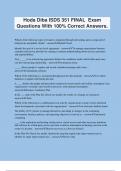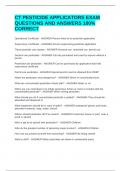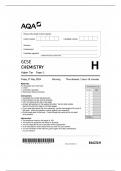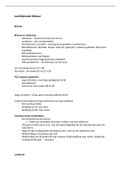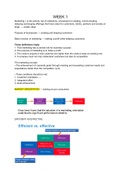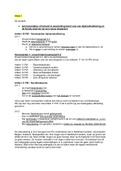Solvay Business School
Academiejaar 2018 - 2019
ONDERZOEKSMETHODEN VOOR
BEDRIJFSKUNDE
1
,Inhoudopgave
1 INTRODUCTION TO RESEARCH METHODS FOR BUSINESS ....................... 11
WETENSCHAPPELIJK ONDERZOEK? ........................................................................11
BUSINESS RESEARCH ........................................................................................11
TOEGEPAST ONDERZOEK VS FUNDUMENTEEL ONDERZOEK ..............................................11
Relevantie voor managers ............................................................................12
ETHICS AND BUSINESS RESEARCH .........................................................................12
2 THE SCIENTIFIC INVESTIGATION: WETENSCHAPPELIJKE EN
ALTERNATIEVE BENADERINGEN IN EEN ONDERZOEK ....................................... 13
8 KENMERKEN VAN WETENSCHAPPELIJK ONDERZOEK. ...................................................13
Doelgericht .................................................................................................13
Rigoureus (= validiteit, strikt, exact) .............................................................13
Testbaar.....................................................................................................14
Reproduceerbaar .........................................................................................14
Precisie en betrouwbaarheid .........................................................................14
Objectief ....................................................................................................14
Veralgemeenbaar, generaliseerbaar ...............................................................15
“Parsimony” (= zuinigheid/ poverheid) ...........................................................15
HYPOTHETISCH-DEDUCTIEF ONDERZOEK ................................................................15
The seven-step process in the hypothetico-deductive method ...........................16
DEDUCTIE & INDUCTIE ......................................................................................17
ALTERNATIEVE BENADERING TOT ONDERZOEK ...........................................................18
Positivisme .................................................................................................18
Constructivisme ..........................................................................................18
Kritisch realisme .........................................................................................19
Pragmatisme ..............................................................................................19
3 HET ONDERZOEKSTHEMA EN PROBLEEMSTELLING DEFINIËREN ............. 20
VERKENNEDE LITERATUURSTUDIE..........................................................................20
BRONNEN .....................................................................................................20
PROBLEEMSTELLING .........................................................................................21
ONDERZOEKSVOORSTEL ....................................................................................23
4 DE KRITISCHE LITERATUURSTUDIE ........................................................ 24
DOEL KRITISCHE LITERATUURSTUDIE .....................................................................25
2
, HOE DE LITERATUURSTUDIE BENADEREN .................................................................26
Bronnen data sources ..................................................................................26
Zoeken naar literatuur .................................................................................28
Literatuur evalueren: leesstrategie ................................................................28
Literatuurstudie documenteren .....................................................................29
ETHISCHE ISSUES............................................................................................30
NUTTIGE BRONNEN VOOR BUSINESS RESEARCH .........................................................31
APA-STIJL OM ARTIKELS TE REFEREREN ..................................................................31
5 THEORETICAL FRAMEWORK & HYPOTHESIS DEVELOPMENT .................... 32
DE NOOD AAN EEN THEORETISCH KADER .................................................................32
VARIABELEN ..................................................................................................32
De afhankelijke variabele .............................................................................33
De onafhankelijke variabele ..........................................................................33
Modererende variabele .................................................................................34
De mediërende of interventie variabele ...........................................................35
THEORETISCH KADER ........................................................................................37
Componenten van een theoretisch kader ........................................................37
ONTWIKKELING VAN HYPOTHESE...........................................................................37
Definitie van een hypothese ..........................................................................37
Statement of hypotheses: formats (verschillende soorten hypothese) ................38
Directionele vs. non-directionele hypothese (gericht vs. non gericht) .................38
Null- en alternatieve hypothese .....................................................................38
HYPOTHESIS TESTING MET KWALITATIEF ONDERZOEK: NEGATIEVE CASE ANALYSE..................39
IMPLICATIES VOOR MANAGERS .............................................................................40
6 ELEMENTEN VAN RESEARCH DESIGN ....................................................... 41
RESEARCH DESIGN ..........................................................................................41
ONDERZOEKSDOEL: VERKENNEND, BESCHRIJVEND, CAUSAAL (VERKLAREND) .......................42
Verkennend onderzoek .................................................................................42
Descriptief, beschrijvend onderzoek ...............................................................43
Verklarend onderzoek (hypothesetestend) ......................................................43
MATE VAN INMENGING VAN DE ONDERZOEKER ...........................................................44
STUDY SETTING: CONTRIVED AND NONCONTRIVED......................................................44
ONDERZOEKSSTRATEGIEËN.................................................................................45
Experiment .................................................................................................45
3
, Survey research/ opinieonderzoek .................................................................46
Observatie/etnografie ..................................................................................46
Case study .................................................................................................47
Grounded theory .........................................................................................47
Action research ...........................................................................................48
Mixed methods............................................................................................48
UNIT OF ANALYSIS: INDIVIDUEN, DYADS, GROEPEN, ORGANISATIES, CULTUREN....................49
TIME HORIZON: CROSS-SECTIONEEL VERSUS LONGITUDINALE STUDIES..............................49
Cross-sectional studies/ one shot studies .......................................................49
Longitudinal studies .....................................................................................50
TRADE-OFFS AND OVEREENKOMSTEN .....................................................................50
IMPLICATIES VOOR MANAGERS .............................................................................51
SAMENVATTING ..............................................................................................52
7 DATA COLLECTION METHODS: INTRODUCTION AND INTERVIEWS .......... 55
INTRODUCTION...............................................................................................55
PRIMAIRE DATAVERZAMELINGSMETHODEN................................................................56
Primaire versus secundaire methoden ............................................................56
Unobtrusive measures .................................................................................57
INTERVIEWING ...............................................................................................58
Unstructured and structured interviews ..........................................................58
Enkele tips om te volgen bij het interviewen ...................................................60
Face-to-face and telephone interviews ...........................................................62
Additional sources of bias in interview data .....................................................63
Computer-assisted interviewing ....................................................................63
Groepsinterview ..........................................................................................63
VOORDELEN EN NADELEN VAN INTERVIEWS ..............................................................66
PROJECTIVE METHODS ....................................................................................66
REVIEW OF INTERVIEWING .................................................................................68
8 DATA COLLECTION METHODS: OBSERVATION ......................................... 69
DEFINITION AND PURPOSE OF RESEARCH .................................................................69
FOUR KEY DIMENSIONS THAT CHARACTERIZE THE TYPE OF OBSERVATION ............................69
Gecontroleerde versus ongecontroleerde observationele studies ........................69
Participant versus geen participant ................................................................70
Gestructureerd versus ongestructureerd .........................................................70
4
, Verborgen versus openlijke observatie ...........................................................70
Andere belangrijke dimensies .......................................................................71
Voorbeelden van observatie: ........................................................................71
TWO IMPORTANT APPROACHES TO OBSERVATION ........................................................72
Participerende observatie: Inleiding ...............................................................72
Het participerende aspect van participerende observatie ..................................73
Het observatie aspect van participerende observatie ........................................74
What to observe? ........................................................................................74
Gestructureerde observatie: Inleiding ............................................................76
The use of coding schemes in structured observation .......................................76
ADVANTAGES AND DISADVANTAGES OF OBSERVATION ..................................................78
Voordelen observatie: ..................................................................................78
Nadelen observatie: .....................................................................................78
9 DATA COLLECTION METHODS: QUESTIONNAIRES ................................... 79
TYPES OF QUESTIONNAIRES ................................................................................79
PERSONALLY, administered questionnaires .....................................................79
Mail & electronic questionnaires ....................................................................79
GUIDELINES FOR QUESTIONNAIRE DESIGN (STAPPENPLAN) PLAN VAN AANPAK ......................81
Inhoud en doel van de vragen .......................................................................81
Taal en formulering van de vragen ................................................................82
Type en vorm van de vragen ........................................................................82
DE VOLGORDE VAN DE VRAGEN: ...........................................................................84
Classificatie gegevens of persoonlijke informatie: ............................................84
Principles of measurement ............................................................................84
General appearance or ‘setup’ of the questionnaire ..........................................85
Pretesting of structured questions .................................................................85
Elektronische vragenlijsten en survey ontwerp ................................................85
INTERNATIONAL DIMENSIONS OF SURVEYS ...............................................................86
Special issues in instrumentation for cross-cultural research .............................86
Issues in data collection ...............................................................................86
REVIEW OF THE ADVANTAGES AND DISADVANTAGES OF DIFFERENT DATA COLLECTION METHODS
AND WHEN TO USE EACH .............................................................................................87
Face –to-face interview: ...............................................................................87
Telefonisch interview: ..................................................................................87
Observatie: ................................................................................................87
5
, Persoonlijk een vragenlijst afleggen: ..............................................................87
Vragenlijsten per post en elektronische vragenlijsten: ......................................87
MULTIMETHODS OF DATA COLLECTION ....................................................................88
MANAGERIAL IMPLICATIONS ................................................................................88
ETHICS IN DATA COLLECTION ..............................................................................88
10 EXPERIMENTAL DESIGNS ........................................................................ 89
THE LAB EXPERIMENT ........................................................................................89
Control....................................................................................................89
Manipulatie ..............................................................................................90
Controlling the contaminating exogenous or ‘nuisance’ variables ....................91
Internal validity of lab experiments ............................................................92
External validity or generalizability of lab experiments ..................................92
THE FIELD EXPERIMENT .....................................................................................93
EXTERNAL AND INTERNAL VALIDITY IN EXPERIMENTS ...................................................93
Trade-off between internal and external validity ...........................................93
Factors effecting the validity of experiments ................................................93
Identifying threats to validity .....................................................................95
Internal validity in case studies ..................................................................95
Review of factors effecting internal and external validity................................96
TYPES OF EXPERIMENTAL DESIGN AND VALIDITY .........................................................96
Quasi-experimental designs .......................................................................96
True experimental designs .........................................................................97
Ex post facto designs ................................................................................99
Threats to validity in the previous experimental designs ................................99
SIMULATION ................................................................................................ 100
ETHICAL ISSUES IN EXPERIMENTAL DESIGN RESEARCH ............................................... 101
MANAGERIAL IMPLICATIONS .............................................................................. 102
11 MEASUREMENT OF VARIABLES: OPERATIONAL DEFINITION ................. 103
HOW VARIABLES ARE MEASURED......................................................................... 103
OPERATIONALISEREN ...................................................................................... 104
Operationalization: dimensions and elements............................................. 105
Operationalizing the (multidimensional) concept of achievement motivation .. 105
Dimensies en elementen van motivatie om te presteren .............................. 106
De kijk van de positivist: ......................................................................... 107
6
, What operationalization is not .................................................................. 107
BESLUIT ..................................................................................................... 108
12 MEASUREMENT: SCALING, RELIABILITY, VALIDITY .............................. 109
FOUR TYPES OF SCALES ................................................................................... 109
Nominal scale ........................................................................................ 110
Ordinal scale .......................................................................................... 111
Interval scale ......................................................................................... 112
Ratio scale............................................................................................. 113
Review of scales ..................................................................................... 113
RATING SCALES ............................................................................................ 115
Dichotomous scale.................................................................................. 115
Category scale ....................................................................................... 115
Semantic differential scale ....................................................................... 116
Numerical scale ...................................................................................... 117
Itemized rating scale .............................................................................. 117
Likert scale ............................................................................................ 118
Fixed or constant sum scale ..................................................................... 118
Stapel scale ........................................................................................... 119
Graphic rating scale ................................................................................ 119
Consensus scale ..................................................................................... 120
Andere schalen ...................................................................................... 120
RANKING SCALES .......................................................................................... 121
Paired comparison .................................................................................. 121
Forced choise ......................................................................................... 121
Comparative scale .................................................................................. 122
INTERNATIONAL DIMENSION OF SCALING ............................................................... 122
GOODNESS OF MEASURES ................................................................................ 122
Item analysis ......................................................................................... 122
Validity ................................................................................................. 123
Reliability .............................................................................................. 125
Review of goodness of measures .............................................................. 126
13 SAMPLING (STEEKPROEFTREKKING) ..................................................... 127
POPULATION, ELEMENT, SAMPLE, SAMPLING UNIT AND SUBJECT..................................... 127
Population ............................................................................................. 127
7
, Element ................................................................................................ 127
Sample ................................................................................................. 127
Sampling unit ........................................................................................ 128
Subject ................................................................................................. 128
Sample frame ........................................................................................ 128
SAMPLE DATA AND POPULATION VALUES ................................................................ 128
Parameters ............................................................................................ 128
Reasons for sampling .............................................................................. 128
Representativeness of samples ................................................................ 128
Normality of distributions ........................................................................ 129
THE SAMPLING PROCESS .................................................................................. 129
Defining the population: .......................................................................... 129
Determining the sample frame: ................................................................ 129
Determining the sample design: ............................................................... 130
Determining the sample size: .................................................................. 130
Executing the sampling process: .............................................................. 131
PROBABILITY SAMPLING ................................................................................... 131
Unrestricted or simple random sampling ................................................... 131
Restricted or complex probability sampling ................................................ 131
NONPROBABILITY SAMPLING.............................................................................. 134
Convenience sampling ............................................................................ 134
Purposive sampling................................................................................. 134
Voor- en nadelen van sampling designs .................................................... 136
Welk sampling design ga je kiezen? .......................................................... 138
EXAMPLES OF WHEN CERTAIN SAMPLING DESIGNS WOULD BE APPROPRIATE ....................... 139
ISSUES OF PRECISION AND CONFIDENCE IN DETERMINING SAMPLE SIZE ........................... 140
Precision ............................................................................................... 140
Confidence ............................................................................................ 141
Sample data, precision and confidence in estimation ................................... 141
Trade-off (afweging) between confidence and precision ............................... 142
SAMPLE DATA AND HYPOTHESIS TESTING ............................................................... 142
THE SAMPLE SIZE .......................................................................................... 142
Determining the sample size .................................................................... 142
Sample size and type II errors ................................................................. 142
Rules of thumb ...................................................................................... 143
8
, Efficiency in sampling ............................................................................. 143
SAMPLING AS RELATED TO QUALITATIVE STUDIES .................................................. 143
MANAGERIAL COMPLICATIONS ........................................................................ 144
14 QUANTITATIVE DATA ANALYSIS ........................................................... 144
DATA BEWERKEN ........................................................................................... 144
15 QUANTITATIVE DATA ANALYSIS: HYPOTHESIS TESTING ...................... 144
16 QUALITATIVE DATA ANALYSIS .............................................................. 145
INLEIDING .................................................................................................. 145
DRIE STAPPEN IN KWALITATIEVE DATA ANALYSE (MILES, HUBERMAN): ............................ 145
Data reduction ....................................................................................... 146
Data display .......................................................................................... 148
Drawing conclusions ............................................................................... 148
RELIABILITY AND VALIDITY IN QUALITATIVE RESEARCH ............................................... 149
SOME OTHER METHODS OF GATHERING AND ANALYZING QUALITATIVE DATA ....................... 150
Content analysis..................................................................................... 150
Narrative analysis................................................................................... 150
Analytic induction ................................................................................... 150
BIG DATA: .................................................................................................. 151
CASE STUDY RESEARCH (NIET IN HET HB) ..................................................... 152
17 THE RESEARCH REPORT......................................................................... 155
THE WRITTEN REPORT ..................................................................................... 155
The purpose of the written report ............................................................. 155
The audience for the written report........................................................... 156
Characteristics of a well-written report ...................................................... 156
CONTENTS OF THE RESEARCH REPORT .................................................................. 156
The title and title page ............................................................................ 156
The executive summary or abstract .......................................................... 157
Table of contents .................................................................................... 157
List of tables, figures, and other materials ................................................. 157
Preface ................................................................................................. 157
The autorization letter............................................................................. 157
The introductory section .......................................................................... 158
The body of the report ............................................................................ 159
9
, The final part of the report ...................................................................... 159
References ............................................................................................ 160
Appendix ............................................................................................... 160
ORAL PRESENTATION ...................................................................................... 160
Deciding on the content .......................................................................... 160
Visual aids ............................................................................................. 160
The presenter ........................................................................................ 160
The presentation .................................................................................... 160
Handling questions ................................................................................. 160
10


